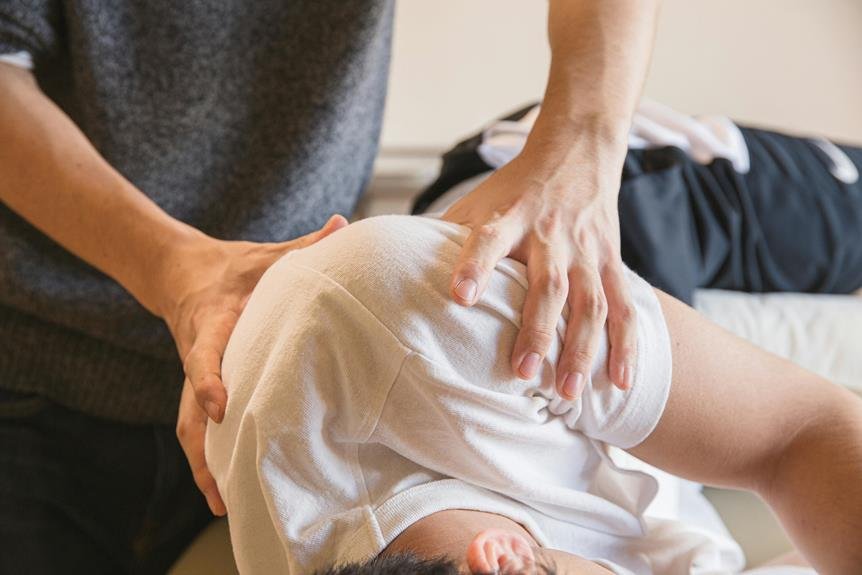Effective Exercises to Relieve Back Pain Quickly
Have you ever felt the relentless tug of back pain disrupting your day? You're not alone.
Discover a range of effective exercises designed to swiftly alleviate your discomfort and bring relief to your back. By incorporating targeted stretches, strength-building routines, and mindful practices into your daily regimen, you can take proactive steps towards improving your back health.
Stay tuned to learn how these exercises can help you regain comfort and mobility, allowing you to embrace each day with renewed vitality.
Stretching Exercises
To effectively alleviate back pain, incorporating regular stretching exercises into your daily routine is essential. Stretching helps improve flexibility, reduce muscle tension, and increase blood flow to the muscles in your back. Begin with gentle stretches, focusing on areas that feel tight or sore. Hold each stretch for 15-30 seconds, breathing deeply to help relax the muscles.
Consider incorporating yoga or Pilates into your routine, as these practices emphasize both stretching and strengthening exercises that can benefit your back. Downward-facing dog, child's pose, and cat-cow are all yoga poses that can help stretch and strengthen your back muscles. Pilates exercises like the pelvic tilt and spine stretch can also improve flexibility and core strength, which are crucial for supporting your back.
Remember to listen to your body and not push yourself too hard during stretching exercises. It's important to maintain proper form and alignment to prevent further injury. By consistently incorporating stretching exercises into your daily routine, you can help alleviate back pain and improve your overall flexibility and strength.
Core Strengthening Workouts
Incorporate core strengthening workouts into your routine to help build a strong foundation for supporting your back and reducing back pain. Exercises like planks, bird dogs, and Russian twists target the muscles in your abdomen, lower back, and pelvis, enhancing stability and reducing the strain on your back. By engaging your core muscles regularly, you can improve your posture, which is crucial for alleviating back pain caused by poor alignment.
Including exercises such as bridges and deadbugs in your workout regimen can also help strengthen the muscles surrounding your spine, providing better support and reducing the risk of injury. These workouts not only target your core but also engage other muscle groups that play a role in maintaining a healthy back.
Consistency is key when it comes to core strengthening. Aim to incorporate these exercises into your routine at least 2-3 times a week to see improvements in your back pain and overall strength. Remember to maintain proper form during each exercise to maximize the benefits and prevent any additional strain on your back.
Pilates for Back Pain Relief
Let's start by focusing on the benefits of Pilates for back pain relief.
Pilates helps strengthen your core, which plays a crucial role in supporting your spine and reducing strain.
Additionally, it promotes flexibility and proper alignment, key elements in alleviating back discomfort.
Core Strength Benefits
Enhancing your core strength through Pilates can significantly alleviate back pain and improve overall spinal health. Pilates focuses on engaging and strengthening deep abdominal muscles, along with muscles surrounding the spine.
By developing core strength, you provide better support for your spine, reducing the risk of strain and injury. A strong core also helps improve posture and body alignment, which can alleviate pressure on the spine.
Additionally, a stable core enhances overall balance and stability, leading to better body mechanics and reduced stress on the back. Regular Pilates practice can help you build a strong foundation, promoting a healthier back and reducing the likelihood of experiencing chronic pain.
Flexibility and Alignment
Building on your core strength foundation with Pilates, focusing on flexibility and alignment is key to relieving back pain effectively.
Pilates exercises emphasize controlled movements that improve flexibility in the spine and surrounding muscles. By engaging in Pilates routines, you work on lengthening and strengthening the muscles, which can alleviate tension and improve overall posture.
Proper alignment plays a crucial role in reducing strain on the back and promoting a healthy spine. Pilates helps you become more aware of your body's alignment, enabling you to make adjustments to support a more neutral spine position.
Incorporating Pilates into your routine can lead to increased flexibility and better alignment, ultimately contributing to back pain relief.
Yoga Poses for Back Health
To improve your back health, incorporating a few key yoga poses into your daily routine can be highly beneficial. Yoga is renowned for its ability to increase flexibility, strengthen muscles, and improve posture, all of which are crucial for a healthy back.
Two poses that specifically target back health are the Cat-Cow stretch and the Child's Pose. The Cat-Cow stretch involves moving between arching your back up like a cat and dipping it down like a cow, which helps to increase flexibility and mobility in the spine. On the other hand, the Child's Pose gently stretches the lower back, hips, thighs, and ankles while promoting relaxation and reducing tension in the back muscles.
Additionally, the Downward-Facing Dog pose can help elongate the spine, strengthen the back muscles, and improve overall posture. Incorporating these poses into your daily routine, even for just a few minutes, can make a significant difference in alleviating back pain and promoting a healthy back long-term.
Low-Impact Aerobic Activities
Incorporate gentle aerobic activities such as walking or swimming to improve back health and reduce pain without causing strain on your body. Low-impact aerobic exercises help strengthen your back muscles, improve flexibility, and increase blood flow to the affected areas.
Walking is a simple yet effective way to get moving and promote healing. Start with short walks and gradually increase the duration as your back gets stronger. Swimming is another excellent option as the water supports your body, reducing the impact on your back while providing a full-body workout. The buoyancy of water also helps improve your range of motion without straining your back.
Engaging in these low-impact aerobic activities can help alleviate back pain by promoting circulation, which aids in the healing process. Additionally, these exercises can enhance your overall physical fitness and mood. Remember to listen to your body and stop any activity that causes pain. Stay consistent with your routine to experience the long-term benefits of improved back health and reduced discomfort.
Foam Rolling Techniques
Let's start by exploring the benefits and proper techniques of foam rolling.
Foam rolling can help alleviate muscle tightness and improve circulation in your back, providing relief from discomfort.
Foam Rolling Benefits
Foam rolling offers numerous benefits for relieving back pain through targeted muscle release and improved blood circulation. By using a foam roller, you can apply pressure to specific areas of your back, helping to release tension and knots in the muscles. This targeted muscle release can help alleviate pain and improve flexibility.
Additionally, foam rolling can aid in improving blood circulation to the muscles in your back, promoting faster recovery and reducing inflammation. The increased blood flow can also help in delivering essential nutrients to the muscles, further aiding in their healing process.
Incorporating foam rolling into your routine can be a beneficial way to address back pain and improve overall back health.
Proper Foam Rolling
Enhance your foam rolling experience by mastering effective techniques for targeted muscle release and improved circulation.
Start by positioning the foam roller under the targeted muscle group. Apply gentle pressure and slowly roll back and forth, focusing on any tight or sore spots. Remember to breathe deeply and relax into the movement.
For larger muscle groups, use longer strokes, and for smaller areas, try more specific movements. If you encounter a particularly tender area, hold the pressure on that spot for a few seconds to help release the tension.
Consistency is key, so aim to foam roll for a few minutes each day to maintain flexibility and reduce back pain effectively.
Stability Ball Exercises
Using a stability ball can significantly improve your core strength and stability, leading to reduced back pain and improved posture. Stability ball exercises engage various muscles in your core, including the abdominals, obliques, and lower back, promoting better spinal alignment and support. One effective exercise is the stability ball plank, where you maintain a plank position with your forearms on the ball and feet on the ground. This strengthens your core while also working on balance and stability.
Another beneficial exercise is the stability ball bridge, where you lie on your back with your feet on the ball and lift your hips towards the ceiling. This movement targets the glutes, hamstrings, and lower back muscles, helping to alleviate pressure on your spine. By incorporating stability ball exercises into your routine, you can enhance your core stability, reduce back pain, and improve your overall posture for a healthier back.
Mind-Body Practices
Incorporating mind-body practices into your exercise routine can further enhance your core strength and stability, contributing to the reduction of back pain and the improvement of posture. Mind-body practices such as yoga and Pilates focus on breathing, mindfulness, and controlled movements to strengthen not only your body but also your mind. These practices help you become more aware of your body's alignment, promoting better posture and reducing the risk of back pain.
Yoga, with its emphasis on flexibility and strength, can help alleviate back pain by stretching and strengthening the muscles that support the spine. Pilates, on the other hand, targets the core muscles, including the muscles of the abdomen and back, which play a crucial role in supporting the spine and maintaining good posture. By incorporating these mind-body practices into your routine, you can improve your overall body awareness, reduce stress levels, and ultimately experience relief from back pain while enhancing your posture.
Frequently Asked Questions
Are There Any Specific Dietary Recommendations That Can Help Alleviate Back Pain?
If you're looking for dietary recommendations to help with back pain, consider foods rich in anti-inflammatory properties like berries, fatty fish, and green leafy vegetables. Staying hydrated and maintaining a healthy weight can also contribute to reducing back pain.
Can Using Heat or Ice Therapy Be Beneficial for Relieving Back Pain?
When managing back pain, remember this: like a soothing balm, heat and ice therapy can work wonders. Heat relaxes tight muscles, while ice reduces inflammation. Alternate between the two to find relief and promote healing.
How Often Should I Incorporate These Exercises Into My Daily Routine to See Results?
To see results, aim to incorporate these exercises into your daily routine. Consistency is key. Start slow and gradually increase frequency. Listen to your body's signals and adjust as needed. Remember, progress takes time and dedication.
Are There Any Specific Sleeping Positions That Can Help Prevent Back Pain?
When dealing with back pain, try sleeping on your side with a pillow between your knees to align your spine. This position can help prevent strain. Experiment to find what works best for you.
Are There Any Alternative Treatments or Therapies That Can Complement These Exercises for Back Pain Relief?
To complement exercises for back pain relief, consider alternative therapies. These can include acupuncture, chiropractic care, or massage. Always consult a healthcare provider to ensure these treatments align with your overall wellness plan.
Conclusion
In conclusion, incorporating a variety of exercises like stretching, core strengthening, and yoga can help alleviate back pain quickly.
By combining these techniques, you can create a strong foundation for a healthy back and overall well-being.
Remember, a balanced approach to fitness and incorporating mind-body practices won't only relieve pain but also improve your posture and flexibility, creating a visual symphony of strength and harmony in your body.






